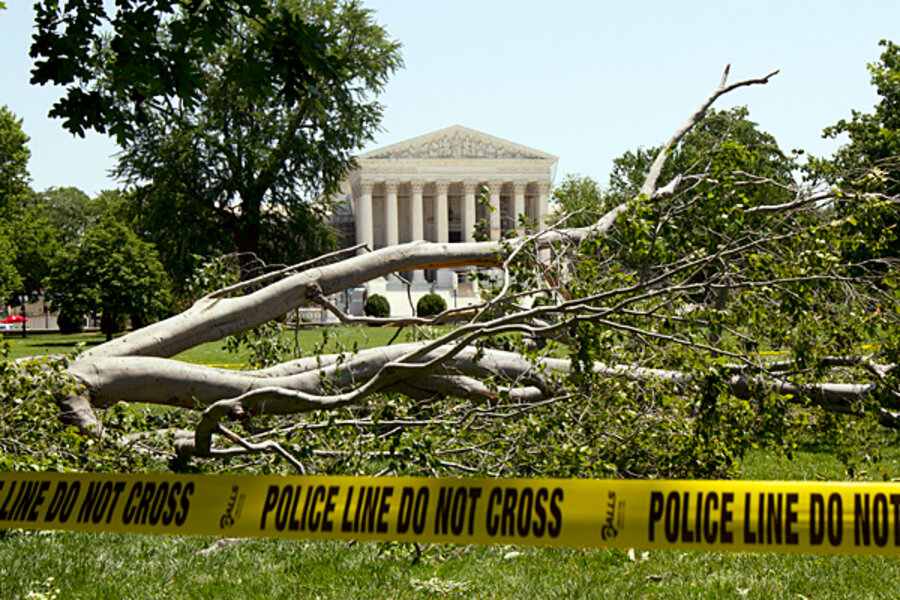Who's in town, who's not as Washington recovers, slowly, from big storm
Loading...
| Washington
Many top federal officials are out of town as Washington recovers – slowly – from a severe storm Friday night that has left more than 2 million utility customers on the East Coast sweltering without air conditioning in record heat for a third day.
As a violent windstorm pounded the Washington area late Friday, members of Congress had already left town for their July 4 recess. The US Supreme Court had delivered its controversial health-care reform decision and closed shop for the summer. Saturday morning, as utilities assessed storm damage, Marine One took off from the White House South Lawn, taking President Obama to Camp David atop a mountain in Maryland, where his family had already begun a brief summer vacation.
GOP presumptive nominee Mitt Romney is also far from the capital, vacationing with his family in New Hampshire.
It is not just officials who had fled the city for the Fourth of July week. Some influential journalists had decamped for the Aspen Ideas Festival in Colorado. Mike Allen of Politico described the gathering this morning in his Playbook memo as “summer camp for D.C. and the Upper East Side: an intellectual utopia where David Brooks is God….”
The pace of recovery from the storm is drawing widespread criticism, from officials such as the governors of Maryland and Virginia as well as from those checking utility company progress reports at 2 a.m. by flashlight in homes where the interior temperature had been pushing triple digits. The US Department of Energy says 2.2 million utility customers remained without power as of 2 p.m. EDT Monday in the 10 states and District of Columbia that suffered storm damage. That is down from a peak of 4.1 million power-deprived customers. The largest of the outages are in Ohio (510,922 customer outages), West Virginia (457,856), Maryland (428,342), and Virginia (454,244), the Energy Department says. The District of Columbia is reporting 41,123 customers without power.
In the nation’s capital and its close-in Maryland and Virginia suburbs, an estimated 445,000 businesses and households remained without power on Monday – some 23.7 percent of customers, the Washington Post reported. That is down from 34 percent without power late Sunday. The local ABC affiliate, WJLA-TV, reported on its website a temperature of 92 degrees F. at 5 p.m.
Key government institutions – the White House, Congress, the Pentagon, and the Supreme Court – have their own emergency generating capacity, although officials are reluctant to comment because of security reasons. “We do maintain emergency generators throughout the Capitol campus,” Eva Malecki, spokeswoman for Architect of the Capitol, said in a terse e-mail response to questions. The Architect provides services to both the Supreme Court and Congress.
Having emergency power at the office does not mean an official will have electricity and air conditioning at home. For example, Chief Justice John Roberts' suburban Maryland home was affected by the same lack of power as of late Saturday as were nearby residences, according to the Monitor’s Gail Russell Chaddock, who lives in the neighborhood.
One way Washington residents coped with the storm’s aftereffects was to stay home from work. The federal government implemented a liberal leave policy on Monday, resulting in a marked reduction in commuter traffic. The Monday afternoon lunch crowd in Farragut Square, three blocks from the White House, was noticeably smaller than usual, with several empty park benches in an area ordinarily filled with workers eating food purchased from vending trucks.
In the online world, Washington-based reactions to the misery brought on by power loss ranged from humor, to a reciting of personal woes, to sober policy warnings. Ron Charles, the Washington Post’s book editor, tweeted, “Why have we lost our electricity in #Bethesda 30 hours AFTER the big storm? (So much ice cream, so little time).”
NBC News political director Chuck Todd was having a challenging weekend. He tweeted, “best part of getting power back, I can resume drying my basement from a leaking water heater. Yeah, it has been that kinda homeowner weekend.”
Amid closed grocery stores, intersections with no signal lights, and long lines for dwindling supplies of gasoline, it was hard not to wonder what would happen if a foreign enemy – rather than a sudden storm – managed to cripple the US power grid. That risk was on the mind of former House Speaker and ex-presidential candidate Newt Gingrich. He tweeted, “Friend and coauthor Bill Forstchen notes Washington-Baltimore blackout mild taste of what an emp (electromagnetic pulse) attack would do.”







